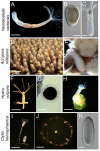Evolutionary crossroads in developmental biology: Cnidaria
- PMID: 21389047
- PMCID: PMC3062418
- DOI: 10.1242/dev.048959
Evolutionary crossroads in developmental biology: Cnidaria
Abstract
There is growing interest in the use of cnidarians (corals, sea anemones, jellyfish and hydroids) to investigate the evolution of key aspects of animal development, such as the formation of the third germ layer (mesoderm), the nervous system and the generation of bilaterality. The recent sequencing of the Nematostella and Hydra genomes, and the establishment of methods for manipulating gene expression, have inspired new research efforts using cnidarians. Here, we present the main features of cnidarian models and their advantages for research, and summarize key recent findings using these models that have informed our understanding of the evolution of the developmental processes underlying metazoan body plan formation.
Figures






References
-
- Ball E. E., Hayward D. C., Reece-Hoyes J. S., Hislop N. R., Samuel G., Saint R., Harrison P. L., Miller D. J. (2002). Coral development: from classical embryology to molecular control. Int. J. Dev. Biol. 46, 671-678 - PubMed
-
- Ball E. E., Hayward D. C., Saint R., Miller D. J. (2004). A simple plan-cnidarians and the origins of developmental mechanisms. Nat. Rev. Genet. 5, 567-577 - PubMed
-
- Bielen H., Oberleitner S., Marcellini S., Gee L., Lemaire P., Bode H. R., Rupp R., Technau U. (2007). Divergent functions of two ancient Hydra Brachyury paralogues suggest specific roles for their C-terminal domains in tissue fate induction. Development 134, 4187-4197 - PubMed
-
- Bode H. R. (1992). Continuous conversion of neuron phenotype in hydra. Trends Genet. 8, 279-284 - PubMed
-
- Bode H. R. (1996). The interstitial cell lineage of hydra: a stem cell system that arose early in evolution. J. Cell Sci. 109, 1155-1164 - PubMed
Publication types
MeSH terms
Grants and funding
LinkOut - more resources
Full Text Sources
Other Literature Sources

